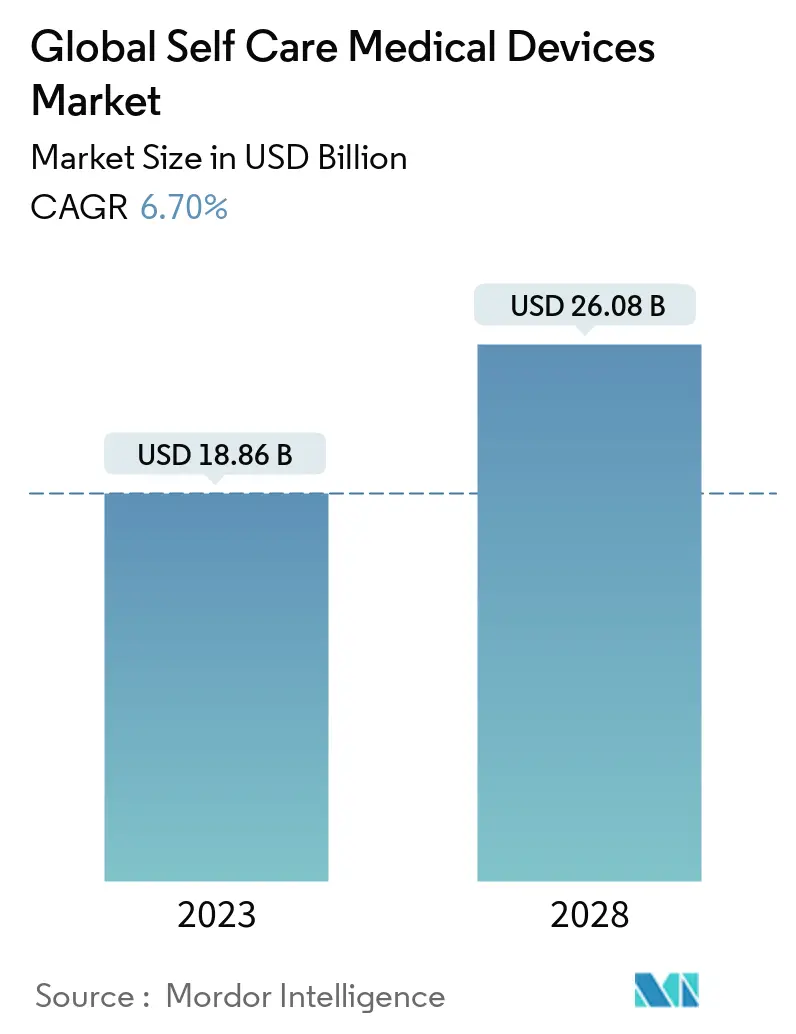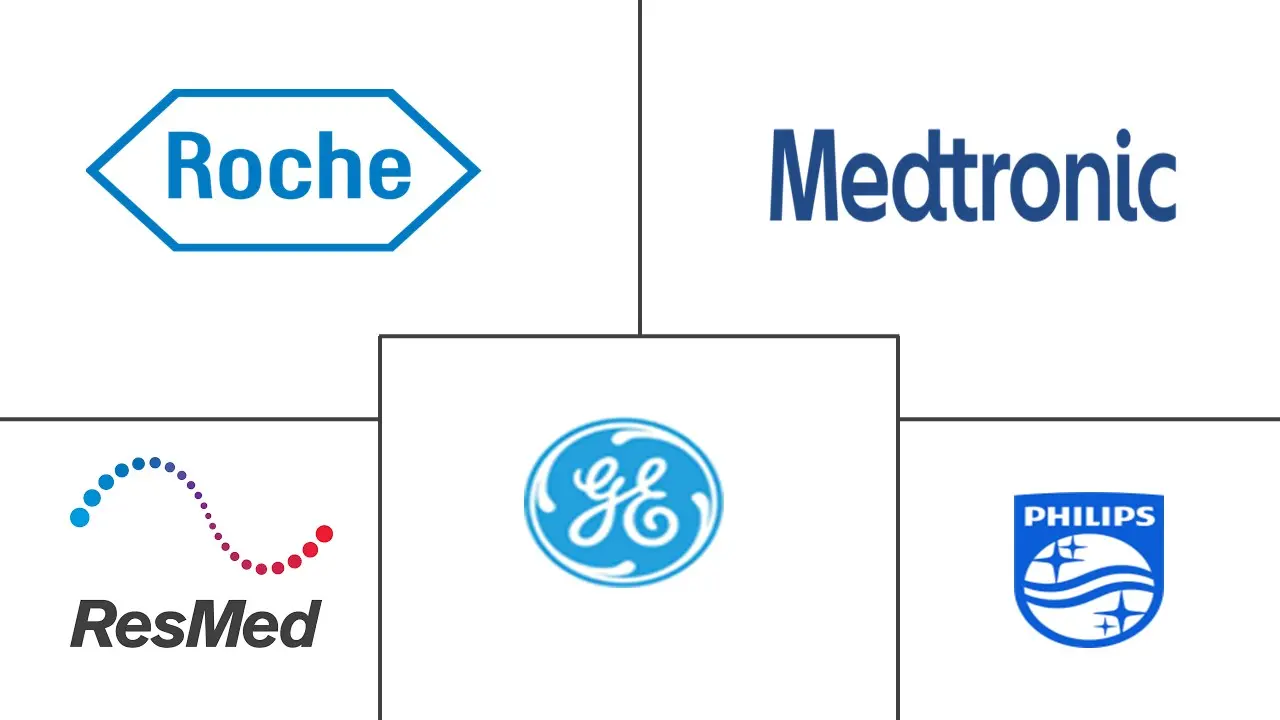Market Size of Global Self Care Medical Devices Industry

| Study Period | 2019 - 2029 |
| Market Size (2024) | USD 20.12 Billion |
| Market Size (2029) | USD 27.83 Billion |
| CAGR (2024 - 2029) | 6.70 % |
| Fastest Growing Market | North America |
| Largest Market | Asia-Pacific |
| Market Concentration | Medium |
Major Players
*Disclaimer: Major Players sorted in no particular order |
Self Care Medical Devices Market Analysis
The Global Self Care Medical Devices Market size is estimated at USD 20.12 billion in 2024, and is expected to reach USD 27.83 billion by 2029, growing at a CAGR of 6.70% during the forecast period (2024-2029).
Globally, the COVID-19 pandemic put enormous pressure on hospitals and healthcare systems that were understaffed and overworked. According to the study titled "Home health monitoring during the COVID pandemic: Results from a feasibility study in Alberta primary care," published in the Healthcare management forum in January 2022, Patients were comfortable with the home healthcare monitoring technology, and more than 60% patients reported an improvement in their quality of life after follow-up. Patients also visited their family physician/emergency department less frequently than in the previous year. Moreover, according to the study titled "Role of self-care in COVID-19 pandemic for people living with comorbidities of diabetes and hypertension" published in the Journal of Family Medicine and Primary Care in November 2020, Dietary precautions, medication adherence, home-based exercises, self-monitoring of blood glucose and blood pressure, salt reduction, self-foot examination, and stress management are all suggested as necessary elements of self-care. Thus, to monitor self-care, the demand for self-care devices increased during COVID-19. Thus, self-care medical devices were positively impacted during the COVID-19 pandemic.
There has been an increase in demand for devices that can continuously track patients' physical well-being due to the rising prevalence of chronic and lifestyle diseases such as cardiovascular disease (CVD) and diabetes, as well as rising consumer health awareness. According to the July 2021 update by the World Health Organization, cardiovascular diseases are the leading cause of death around the world, including diseases like coronary heart disease, cerebrovascular disease, rheumatic heart disease, congenital heart disease, and others. Additionally, according to the data published by the International Diabetes Federation (IDF) Diabetes Atlas Tenth Edition 2021, in the year 2021, approximately 537 million adults (aged 20-79 years) were living with diabetes. The same source estimated that the total number of people living with diabetes is projected to rise to 643 million by 2030 and 783 million by 2045. The rising burden of diabetes is likely to increase the demand for more technically advanced self-care medical devices.
Furthermore, according to the WHO, by 2030, one out of every six people on the planet will be 60 years old or older. The number of people aged 60 and up is expected to rise from 1 billion in 2020 to 1.4 billion by 2050. By 2050, the global population of people aged 60 and above will get double to reach 2.1 billion. Between 2020 and 2050, the number of people aged 80 and above is expected to triple, reaching 426 million.
The market players adopted various strategies such as product launches, product developments, collaborations, and expansions to increase their market revenue. For instance, in November 2021, Abbott, the global healthcare launched the FreeStyle Libre system, the continuous glucose monitoring (CGM) technology available for adults and children (above the age of four) living with diabetes in India and women with gestational diabetes (diabetes during pregnancy), allowing them to check their glucose levels at any time and from any location, resulting in better glucose control.
Thus, all aforementioned factors are anticipated to drive the market over the forecast period. However, the availability of alternative devices and the high cost of the products restraint the market over the forecast period.
Self Care Medical Devices Industry Segmentation
As per the scope of the report, self-care medical devices are used for monitoring and maintaining vital parameters of patients such as blood sugar level, blood pressure, and heart rate. These devices can be used by the patients themselves and do not require the presence of a medical professional. The Self Care Medical Devices Market is Segmented by Type (Blood Glucose Monitors, Blood Pressure Monitors, Body Temperature Monitors, Nebulizers, Pedometers, Pregnancy/Fertility Test Kits, and Others), and Geography (North America, Europe, Asia-Pacific, Middle-East and Africa, and South America). The market report also covers the estimated market sizes and trends for 17 different countries across major regions, globally. The report offers the value (in USD million) for the above segments.
| By Type | |
| Blood Glucose Monitors | |
| Blood Pressure Monitors | |
| Body Temperature Monitors | |
| Nebulizers | |
| Pedometers | |
| Pregnancy/Fertility Test Kits | |
| Others |
| Geography | ||||||||
| ||||||||
| ||||||||
| ||||||||
| ||||||||
|
Global Self Care Medical Devices Market Size Summary
The self-care medical devices market is experiencing significant growth, driven by the increasing prevalence of chronic and lifestyle diseases such as cardiovascular conditions and diabetes, alongside rising consumer health awareness. The COVID-19 pandemic has further accelerated this trend, as it highlighted the importance of home healthcare monitoring technologies, leading to a surge in demand for self-care devices. These devices enable patients to manage their health conditions more effectively, reducing the need for frequent visits to healthcare facilities. The market is characterized by a variety of strategies employed by key players, including product launches, collaborations, and expansions, aimed at enhancing market share and revenue. The introduction of advanced technologies, such as continuous glucose monitoring systems, has also contributed to the market's expansion, particularly in regions with a high burden of diabetes and an aging population.
In the United States, the shift towards self-care monitoring has been particularly pronounced, with telehealth services gaining traction during the pandemic. The high prevalence of diabetes and other chronic conditions among the aging population is driving the demand for self-care medical devices, as these devices offer convenient and efficient ways to monitor health metrics at home. The market is moderately fragmented, with numerous manufacturers competing to innovate and capture market share. Partnerships and agreements between industry participants are becoming more common, as companies seek to integrate self-care functionalities into their devices. Key players in the market include Medtronic, Philips, Bayer HealthCare, and Johnson & Johnson, among others, who are actively working to develop and promote new products to meet the growing demand for self-care medical devices.
Global Self Care Medical Devices Market Size - Table of Contents
-
1. MARKET DYNAMICS
-
1.1 Market Overview
-
1.2 Market Drivers
-
1.2.1 Rising Burden of Chronic Diseases and Lifestyle Diseases Coupled with The Geriatric Population
-
1.2.2 Growing Preference for Home- Based Treatment Due to Hectic Lifestyle
-
-
1.3 Market Restraints
-
1.3.1 Availability Of Alternative Options, And High Costs of Devices.
-
1.3.2 Side Effects and Risks Associated with Implantation of Self-Care Medical Devices
-
-
1.4 Porter's Five Forces Analysis
-
1.4.1 Threat of New Entrants
-
1.4.2 Bargaining Power of Buyers/Consumers
-
1.4.3 Bargaining Power of Suppliers
-
1.4.4 Threat of Substitute Products
-
1.4.5 Intensity of Competitive Rivalry
-
-
-
2. MARKET SEGMENTATION (Market Size by Value - USD million)
-
2.1 By Type
-
2.1.1 Blood Glucose Monitors
-
2.1.2 Blood Pressure Monitors
-
2.1.3 Body Temperature Monitors
-
2.1.4 Nebulizers
-
2.1.5 Pedometers
-
2.1.6 Pregnancy/Fertility Test Kits
-
2.1.7 Others
-
-
2.2 Geography
-
2.2.1 North America
-
2.2.1.1 United States
-
2.2.1.2 Canada
-
2.2.1.3 Mexico
-
-
2.2.2 Europe
-
2.2.2.1 Germany
-
2.2.2.2 United Kingdom
-
2.2.2.3 France
-
2.2.2.4 Italy
-
2.2.2.5 Spain
-
2.2.2.6 Rest of Europe
-
-
2.2.3 Asia-Pacific
-
2.2.3.1 China
-
2.2.3.2 Japan
-
2.2.3.3 India
-
2.2.3.4 Australia
-
2.2.3.5 South Korea
-
2.2.3.6 Rest of Asia-Pacific
-
-
2.2.4 Middle-East and Africa
-
2.2.4.1 GCC
-
2.2.4.2 South Africa
-
2.2.4.3 Rest of Middle-East and Africa
-
-
2.2.5 South America
-
2.2.5.1 Brazil
-
2.2.5.2 Argentina
-
2.2.5.3 Rest of South America
-
-
-
Global Self Care Medical Devices Market Size FAQs
How big is the Global Self Care Medical Devices Market?
The Global Self Care Medical Devices Market size is expected to reach USD 20.12 billion in 2024 and grow at a CAGR of 6.70% to reach USD 27.83 billion by 2029.
What is the current Global Self Care Medical Devices Market size?
In 2024, the Global Self Care Medical Devices Market size is expected to reach USD 20.12 billion.

